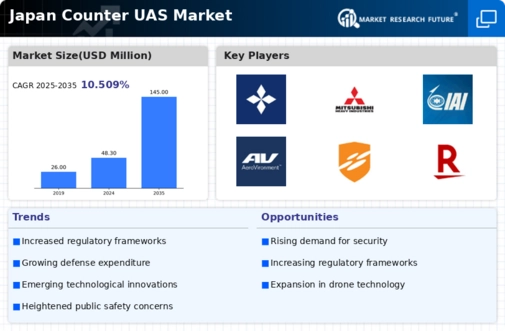The Japan Counter UAS Market has witnessed significant growth over the past few years, primarily driven by the increased awareness surrounding drone-related threats and the necessity for enhanced security measures. This burgeoning market comprises a range of technologies and services aimed at detecting, tracking, and neutralizing unauthorized unmanned aerial systems.
The competitive landscape is characterized by an influx of domestic and international players, each vying for a share in this lucrative segment. As governments and private sector entities ramp up their investments in counter-drone technologies, the market dynamics are reshaped continuously, reflecting innovation, regulatory developments, and strategic partnerships.
Players in this field are diversifying their offerings to address specific security requirements, ensuring that they remain relevant in a rapidly evolving environment. General Atomics has established a notable presence in the Japan Counter UAS Market, leveraging its strong technological capabilities and robust product portfolio.
The company's strengths lie in its advanced sensors and countermeasure systems, which have proven effective in various security scenarios. General Atomics' commitment to research and development ensures that it stays at the forefront of counter-drone technology, providing cutting-edge solutions to meet the unique demands of the Japanese market.
The company collaborates closely with local government agencies and defense authorities to custom-tailor its offerings, aligning its objectives with the national security strategies of Japan. Additionally, its reputation for reliability and operational excellence boosts its appeal among clients seeking long-term partnerships.
Mitsubishi Heavy Industries has a distinguished role in the Japan Counter UAS Market, offering an array of cutting-edge technologies that encompass radar systems, electronic warfare, and integrated defense platforms. The company is well-positioned in the market, capitalizing on its strong legacy in aviation and defense.
Mitsubishi Heavy Industries focuses on developing systems that enhance surveillance capabilities and protect critical infrastructure from potential aerial threats. The firm has embarked on various collaborations and partnerships that amplify its market presence, while its continuous investment in innovation ensures that its solutions remain competitive.
Additionally, Mitsubishi Heavy Industries has not shied away from strategic mergers and acquisitions to bolster its capacity, further expanding its product portfolio to address the complexities of modern aerial threats in Japan. This synergy between historical expertise and contemporary innovations reinforces its standing in the competitive landscape of the counter-drone market.


















Leave a Comment